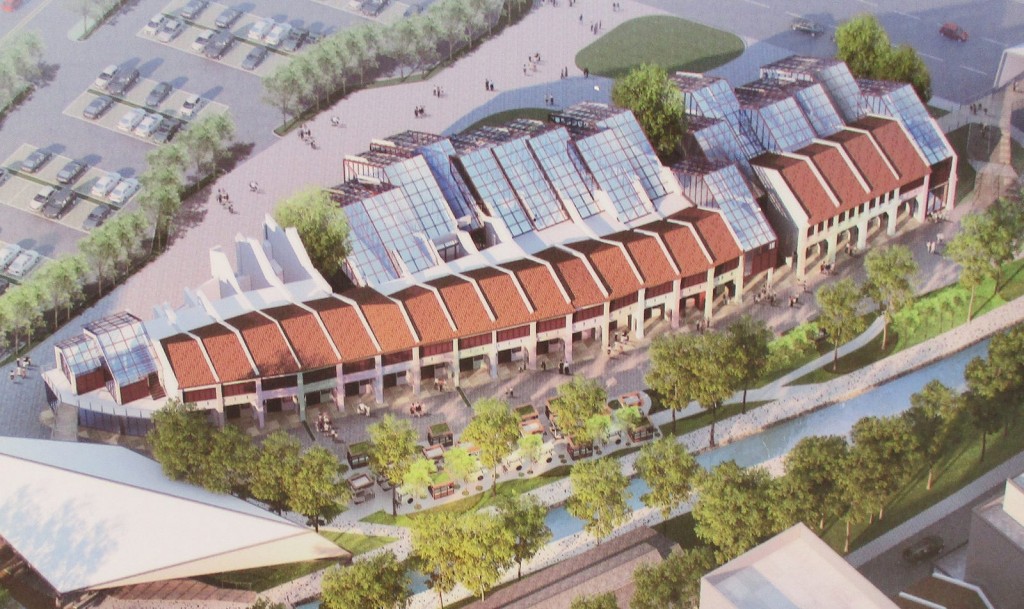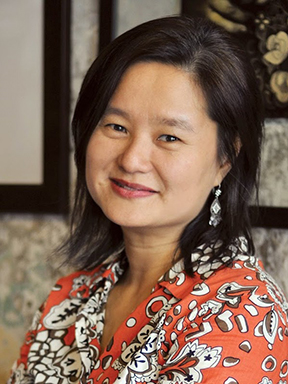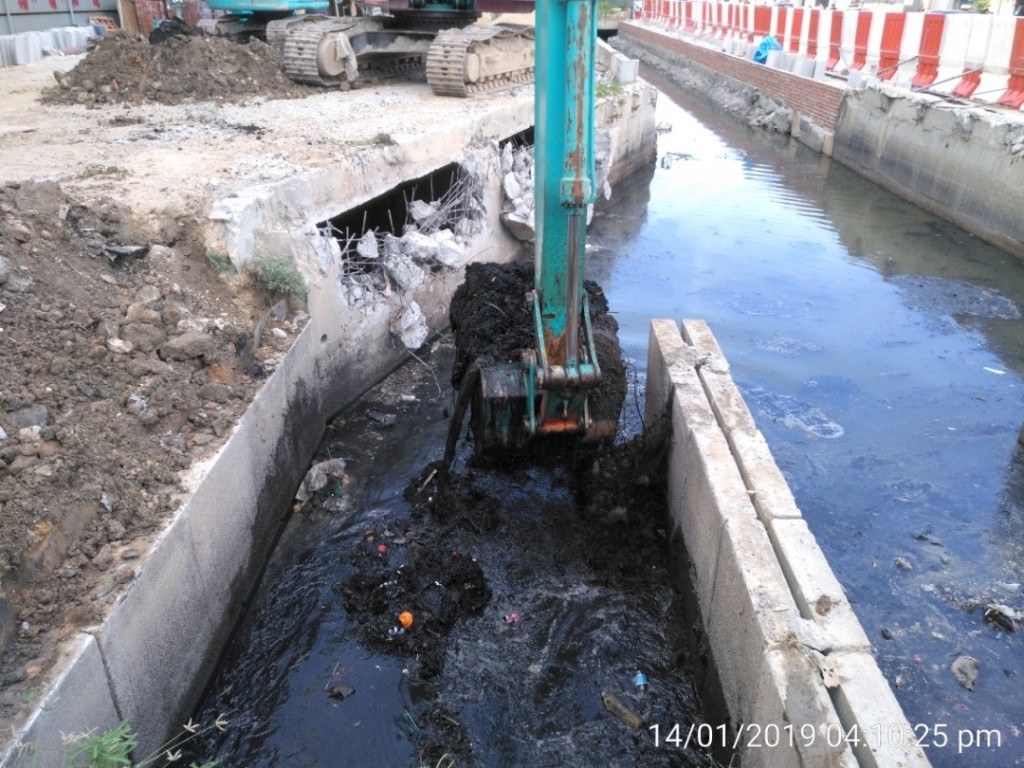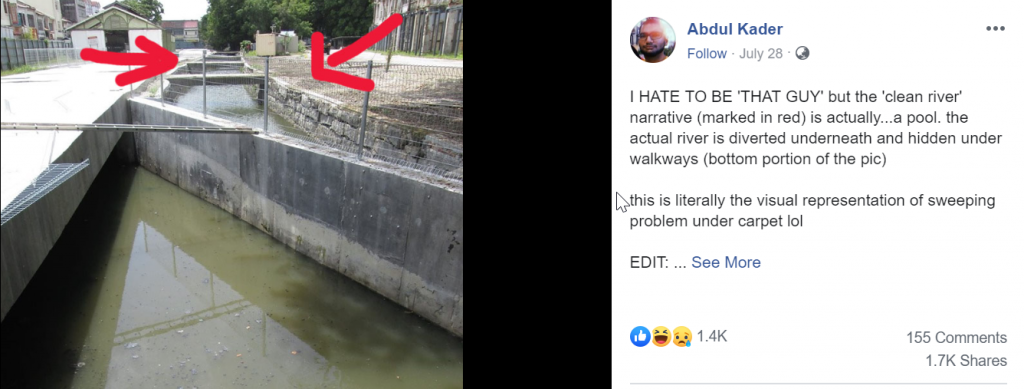We walked upstream along Penang’s Prangin ‘river’. Here’s what we found

- 1.3KShares
- Facebook1.2K
- Twitter19
- LinkedIn22
- Email33
- WhatsApp90
We’ve all seen it: the image of the crystal-clear Prangin Canal in Penang with koi fishes swimming in it, with the caption comparing the sight to rivers in Japan:

Now, when we saw it we too were impressed at the apparent progress taken by the Penang gomen to clean up their act, so to speak. However, things got a little fishy after this follow up image was posted..
Abdul Kader’s claim of ‘sweeping problem under the carpet’ sparked intense debate among netizens, Penangites and non-Penangites alike. The issue gained even more traction after Penang Forum, a Penang-based environmental NGO, alleged that the Penang gomen was simply ‘hiding’ the dirty water to give a false impression of river rehabilitation, which prompted the Penang gomen to bite back.
“This is a very disgusted and uncalled for comment by the Penang Forum, a small group of people who just doesn’t want to see any improvement or development in the beloved state of Penang.” – Penang ADUN Daniel Gooi
But you probably saw all that already. Amazingly, CILISOS has a writer based 10 minutes away from Prangin Canal, so, in order clear the air (or in this case, water), we actually went on-site to the Prangin Canal in Penang to to take a closer look!
There are rejuvenation works going on all around the Canal


(Apologies for the unflattering angles, the area was still closed to the public so this was the best we could do)
Alright, so first off for the non-Penangites reading this, there’s a part of George Town called Sia Boey, and as part of the state govt’s attempt to breathe some life into this part of town, they introduced the Sia Boey Rejuvenation Project to…
“… transform Sia Boey into a site where development and heritage conservation can coexist… an urban park that emphasises heritage.” – Lim Guan Eng, then-Chief Minister of Penang (2018)
‘Sia Boey’ in Hokkien means ‘Town’s End’, or literally, ‘tail end of the settlement’. In its heyday (circa-19th century), it served as an entry point for tongkang (boats) coming into Penang via the Prangin Canal, hence the name. Along with George Town’s booming population at the time, the Sia Boey Market flourished and became a vibrant wet market, where it was common to see people selling fish, onions, potatoes, rattan products, animal products, basketware, animal feed, fertilizers and pesticides, and so on.


However, by the 1970s, with increasing urbanisation and the advent of motor vehicles in George Town, the Prangin Canal started to get polluted and eventually, much of it was covered up by roads and buildings.
So the Sia Boey canal was proposed to be rejuvenated… 3 times since 2000
Ok guys, get ready for a whole bunch of ‘artist concept pictures’.
The 2018 rejuvenation plan wasn’t the first… this market has had no less than 4 make-over proposals in 18 years.
- Early 2000s – The entire Sia Boey Wholesale Market was to be relocated to Macallum Street Gaut to make way for the development of KOMTAR Phase 5, and to restore Prangin Canal and Sia Boey Market to its former glory. However, it was eventually delayed due to heritage concerns, and never came to fruition in the end.

- 2015 – LGE launches “Sia Boey Reborn: Penang Heritage Arts District”, on the advice of then-mayor of Penang and GM of George Town World Heritage Incorporated (GTWHI), Datuk Maimunah Mohd Sharif. Scope was the same as KOMTAR Phase 5 , tambah a world-class art museum.
- 2015-16 – USM archaeologists discover the Old Prangin Canal Basin, alongside a police barracks and thousands of other artefacts. Penang Gomen super-keen to proceed.


- 2016 – Sia Boey Reborn project stillborn, in favour of the Penang Transport Master Plan, introduced in 2016 with an estimated cost of around RM46 billion. To give y’all an idea of what this is supposed to be, think a giant BTS/KL Sentral-ish transport hub, but an island version of it.

That last one is the one that really annoyed Penang Forum, who, concerned by the threat posed by development to the Sia Boey heritage site, raised its concerns to the gomen, which were allegedly ignored. Because of this, Penang Forum wrote a letter to Unesco to request for a heritage assessment of the site, resulting in the GTWHI general manager, the head of the state think-tank, and a few DAP politicians (including Lim Guan Eng himself) to accuse Penang Forum of backstabbing the state gomen. Heavy stuff.
“If Penang Forum is again called ‘anti-Penang’ for pointing out the truth, so be it.” – Khoo Salma, as quoted from New Straits Times
Eventually, the gomen decided to relocate the proposed LRT station to the nearby Jalan Magazine, and proceeded to introduce yet another Sia Boey rejuvenation project, this time called… the Sia Boey Rejuvenation Project. Surprise surprise.

The 2018 incarnation of the Sia Boey Re-re-rejuvenation Project, aims for a ‘doing more by doing less’ approach, to recreate Sia Boey as a green lung urban park and local traditional arts trading venue, while protecting Sia Boey’s heritage buildings and practices. The project is currently being carried out in three phases:
- The restoration of the old Prangin Canal, culminating in a water system test.
- The rejuvenation of the market hall and landscaping, as well as a public archaeology programme for children.
- The restoration and adaptive reuse of the 22 shophouses on-site, as well as the conversion of some of the buildings into the new Prangin Archaeological Gallery.
Here are more pretty conceptual pictures…



Ok, so what about the dirty water that was diverted underneath walkways? Is the Penang gomen really trying to ‘sweep the problem under the carpet’, as claimed by critics? The answer to that, much like our relationship status, is complicated.
We followed the ‘river’ all the way back to KOMTAR, and found something…
Y’know that ‘river‘ (in quotes as it’s not actually a natural ‘river’, but a stormwater drain) that was being diverted and hidden under walkways? We followed the stream leading back towards the KOMTAR/Prangin Mall area, and this is what we saw:


We’ll admit, the sight doesn’t look (or smell) pretty, but there’s actually a bigger part of the story here: though we saw that the dirty drain water has indeed been diverted, we later found out that it’s part of the S10 joint flood mitigation measure by MBPP and PDC (a project partner of the aforementioned GTWHI).
Earlier, Khoo Salma of Penang Forum had accused the Penang gomen of not being transparent regarding the issue of dirty water in the Sia Boey Rejuvenation Project:
“Ideally, the project could have been a real river clean-up starting from upstream, to upgrade the Sungai Prangin to make it suitable for body-contact recreational use. However, river rehabilitation was not part of the state’s vision from the beginning. The urgent thing now was to save it from being obliterated by the (PTMP) transport hub.” – Khoo Salma

In response, MBPP councillor Nicholas Theng said that cleaning efforts had actually been underway as part of S10 and that doing it in conjuction with the Sia Boey Rejuvenation Project would allow MBPP greater access to the drain, something which had hindered cleaning efforts over the past 20 years.
He also claimed that Khoo was acting irresponsibly by trying to mislead the people into believing that S10 and the Sia Boey Rejuvenation Project were one in the same, making clear that they were not, but rather two separate projects done together in order to enable each other:
“Two access points to clean the monsoon drain have been created. This was done together with the diversion in Sia Boey so that the iconic place can be properly rejuvenated and MBPP has access to clean up the storm drain from hereon.” – Nicholas Theng, MBPP councillor

These statements were echoed by the PDC/GTWHI
“We can’t break it apart to build a wider drain for the flood mitigation so instead we built a parallel wider drain for flood mitigation while maintaining the Prangin Canal due to its historic significance.” – Datuk Yeoh Lean Huat, PDC Senior Deputy General Manager
“What did we hide? Well, we did not mention that we planted at least 177 new trees nor did we mention that a total 4,000 hours were spent throughout eight months of intensive sifting through the silt deposit from the canal.” – Ang Ming Chee, George Town World Heritage Inc (GTWHI) general manager
PDC/GTWHI added in their joint official statement that they were implementing various hi-tech solutions to keep the water clean, such as a bio-filtration system, an Ultra-Violet Light system, as well as a Japanese technology called ‘effective microorganisms’.

Nicholas Theng also made sure to make the distinction between ‘river’ and ‘drain’, saying that since ‘Sungai Prangin’ no longer exists in modern-day George Town, there is no longer a ‘river’ to clean:
“A monsoon drain should be called a monsoon drain, just like how a spade should be called a spade.” – Nicholas Theng, MBPP councillor

However, that eventually degenerated into a cyberwar with both sides calling each other cybertroopers. Sigh…


As of the time of writing, a total of RM9,027,000 has been spent on the entire rejuvenation project so far. Let’s hope this wasn’t where it was spent.
Cleaning rivers ain’t easy. Klang river also failed to do the same.

Dirty rivers/streams/drains/*insert noun indicating flowing body of water here* are not a new thing in Malaysia; in fact, the issue of Penang’s dirty rivers has plagued the state for over 40 years. We’ve also previously written how a 7-year clean up effort of the Klang River was severely underestimated.
However, there are countries like Singapore who have used their millions to make their river cleanup dreams a reality. It’s also worth noting that sometimes, it doesn’t always take millions of ringgit to clean up our act; take these villagers in Indonesia who managed to solve their river pollution problem with the lowest-tech solution possible: working together.
The trick is really to get to the source of the pollution in the first place, and often times… that source is us.
With the Prangin ‘fish canal’ not quite a result of a cleanup, and illegal dumping of rubbish still a big issue in Penang, perhaps the congratulating of Penangites was a little premature.
- 1.3KShares
- Facebook1.2K
- Twitter19
- LinkedIn22
- Email33
- WhatsApp90




